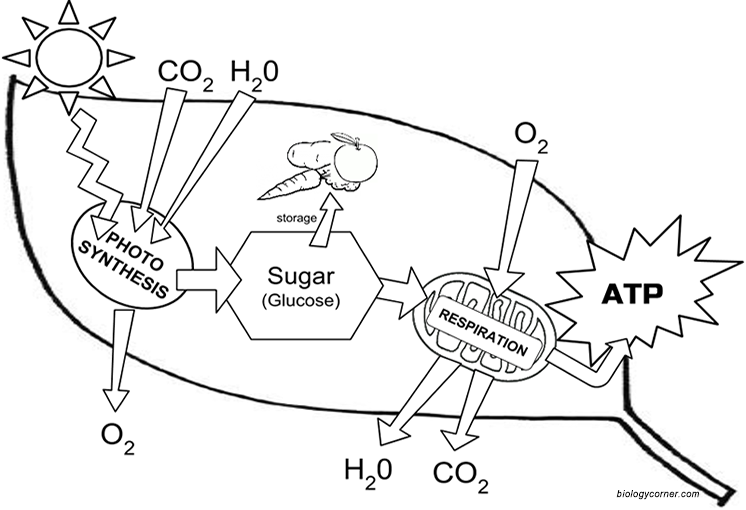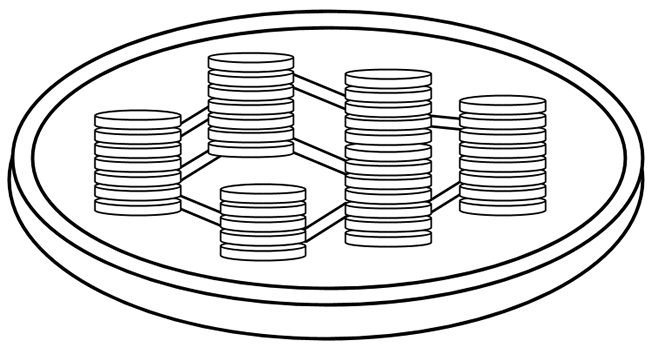How Do Chloroplasts Capture Energy from the Sun?
Plant cells and some algae contain an organelle called the chloroplast. The chloroplast allows plants to harvest energy from sunlight, a process known as photosynthesis. Specialized pigments in the chloroplast absorb sunlight and use this energy to combine carbon dioxide and water to make glucose and oxgyen. The complete reaction is:
6CO2 + 6H2O → C6H12O6 + 6O2
Raw Materials
CO2 = carbon dioxide
H2O = waterProducts
C6H12O6 = glucose
O2 = oxygen
Plant cells can use this process to manufacture glucose, a simple sugar. Some of the glucose is used immediately for cellular respiration, where it is converted to a high energy compound called ATP. You might recall from studies of the cell, that the process of creating ATP occurs in the mitochondria. Glucose that is not used right away is packaged as carbohydrates or fats and then stored in the roots, seeds, and fruits.
All autotrophs can make their own food in this way, unlike heterotrophs, which much consume food. When you eat a potato, you are eating the carbohydrates that the plant created from sunlight.
| Sun & Energy = yellow |
Carbon Dioxide = red |
| Photosynthesis= green |
Respiration = purple |
| Storage Products= brown |
ATP = orange |
| Water = light blue |
Glucose = dark blue |
| Oxygen = pink |

Questions:
1. What two types of cells contain chloroplasts? ___________________________________________
2. Autotrophs make their own food using energy from __________________________________
3. The food making process is called _______________________________
4. What are the raw materials for photosynthesis? ____________________________
5. What simple sugar is produced? ______________________________
6. What gas is used in the process? ______________ What gas is released? ________________
7. Where are most photosynthetic cells in plants found? _________________________
8. What compound can be made from glucose and serves as long term energy storage? ________________
9. Compare the raw materials of photosynthesis to the products of respiration. How are these two processes related.
The Structure of the Chloroplast
Chloroplasts are double membrane organelles with a smooth outer membrane and an inner membrane that is folded into disc-shaped sacs called the thylakoid. Color and label the outer membrane light green ![]() . Color and label the inner membrane brown
. Color and label the inner membrane brown ![]() .
.
Thylakoids contain chlorophyll and other pigments (red, orange, yellow, brown) and are found in stacks called granum (grana, plural.) Color and label the thylakoids dark green ![]() , then highlight the entire stack of granum with yellow
, then highlight the entire stack of granum with yellow ![]() . These stacks are connected to other stacks by channels called lamellae. Color and label the lamella orange.
. These stacks are connected to other stacks by channels called lamellae. Color and label the lamella orange.![]()
Grana are surrounded by a gel-like material called stroma. Color and label the stroma blue. ![]()

10. How many membranes surround a chloroplast? _____
11. Thylakoids form stacks called ____________________
12. Stacks of granum are connected to each other by ___________________________
Other Resources on Photosynthesis
Plant Pigments – Use chromatography to observe plant pigments separate
Photosynthesis Simulation – this simulator uses light and varying levels of carbon dioxide to explore rates of photosynthesis, replaces the waterweed simulator
Photosynthesis Lab – AP Lab, uses spinach leaves and light to measure the rate of photosynthesis. Oxygen bubbles cause leaf disks to float when they are exposed to light.
Calvin Cycle (TED-Ed) – video worksheet with labeling and practice questions
Investigate Photosynthesis with Vernier Probes – explore changes in oxygen levels in plants exposed to light

